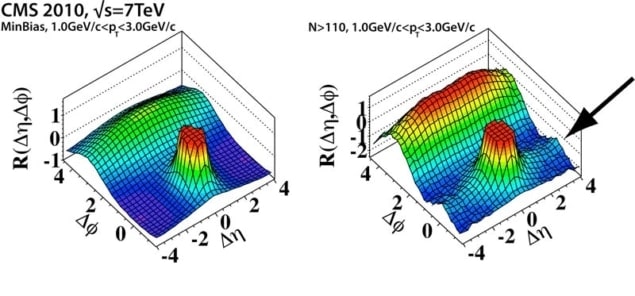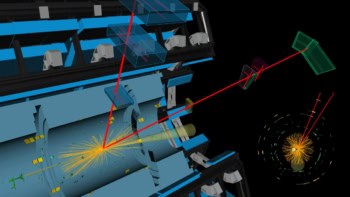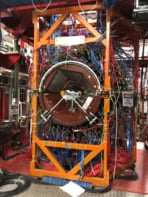
A subtle and unexpected signal in data from the Large Hadron Collider (LHC) in Geneva could mean that the proton accelerator is capable of creating a “hot soup” of interacting particles called a quark–gluon plasma.
The result comes as a surprise because physicists had believed that colliding protons at the LHC should not create such a plasma – hints of which have already been spotted by the RHIC accelerator in the US, which smashes heavy ions such as gold together.
Hundreds of particles
When two protons collide at 7 TeV at the LHC, hundreds of particles can sometimes be produced and detected. In order to understand the underlying physics, physicists look for correlations between the angles at which pairs of particles fly away from the point of impact.
Researchers using the Compact Muon Solenoid (CMS) experiment at the LHC had expected that a plot of the correlations would show a peak where the angles are zero, which would mean that the particles are leaving the collision point in a jet pointing in a specific direction. Instead, the peak seems to be riding on top of a ridge-like structure. This suggests that some particles are heading off in completely different directions – and correlations between pairs of these wayward particles are set by some sort of interaction between the particles when they were created in the collision.
One possible interpretation of the ridge is that the collision creates a dense fluid of many quarks and gluons – a quark–gluon plasma – which then condenses to produce the detected particles. The collective motion of the plasma could be transferred to the particles, resulting in the mysterious correlations. The problem with this explanation is that protons in the LHC shouldn’t create such a plasma.
New physics?
Another possibility is that CMS has caught sight of a hitherto unknown collective process that occurs when protons collide – something that would require a significant revision of our understanding of such collisions.
“Now we need more data to analyse fully what’s going on, and to take our first steps into the vast landscape of new physics we hope the LHC will open up,” said CMS spokesperson Guido Tonelli.
The exact nature of the quark–gluon plasma is of great interest to physicists because the universe is believed to have been such a hot soup shortly after the Big Bang.
The results are described in a preprint on the arXiv server.



